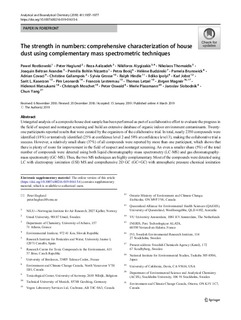The strength in numbers: comprehensive characterization of house dust using complementary mass spectrometric techniques
Rostkowski, Pawel Marian; Haglund, Peter; Aalizadeh, Reza; Alygizakis, Nikiforos; Thomaidis, Nikolaos; Arandes, J.; Bohlin-Nizzetto, Pernilla; Booij, P.; Budzinski, Hélène; Brunswick, Pamela; Covaci, Adrian; Gallampois, Christine; Grosse, Sylvia; Hindle, R.; Ipolyi, Ildiko; Jobst, Karl; Kaserzon, Sarit; Leonards, Pim; Lestremau, F.; Letzel, Thomas; Magnér, Jörgen; Matsukami, Hidenori; Moschet, C.; Oswald, Peter; Plassmann, M.; Slobodnik, Jaroslav; Yang, Chun
Journal article, Peer reviewed
Published version
Permanent lenke
http://hdl.handle.net/11250/2596904Utgivelsesdato
2019Metadata
Vis full innførselSamlinger
- Publikasjoner fra Cristin - NILU [1329]
- Vitenskapelige publikasjoner [1068]
Originalversjon
Analytical and Bioanalytical Chemistry. 2019, 411 1957-1977. 10.1007/s00216-019-01615-6Sammendrag
Untargeted analysis of a composite house dust sample has been performed as part of a collaborative effort to evaluate the progress in the field of suspect and nontarget screening and build an extensive database of organic indoor environment contaminants. Twenty-one participants reported results that were curated by the organizers of the collaborative trial. In total, nearly 2350 compounds were identified (18%) or tentatively identified (25% at confidence level 2 and 58% at confidence level 3), making the collaborative trial a success. However, a relatively small share (37%) of all compounds were reported by more than one participant, which shows that there is plenty of room for improvement in the field of suspect and nontarget screening. An even a smaller share (5%) of the total number of compounds were detected using both liquid chromatography–mass spectrometry (LC-MS) and gas chromatography–mass spectrometry (GC-MS). Thus, the two MS techniques are highly complementary. Most of the compounds were detected using LC with electrospray ionization (ESI) MS and comprehensive 2D GC (GC×GC) with atmospheric pressure chemical ionization (APCI) and electron ionization (EI), respectively. Collectively, the three techniques accounted for more than 75% of the reported compounds. Glycols, pharmaceuticals, pesticides, and various biogenic compounds dominated among the compounds reported by LC-MS participants, while hydrocarbons, hydrocarbon derivatives, and chlorinated paraffins and chlorinated biphenyls were primarily reported by GC-MS participants. Plastics additives, flavor and fragrances, and personal care products were reported by both LC-MS and GC-MS participants. It was concluded that the use of multiple analytical techniques was required for a comprehensive characterization of house dust contaminants. Further, several recommendations are given for improved suspect and nontarget screening of house dust and other indoor environment samples, including the use of open-source data processing tools. One of the tools allowed provisional identification of almost 500 compounds that had not been reported by participants.

